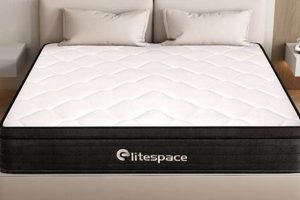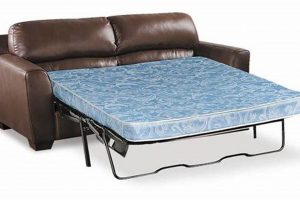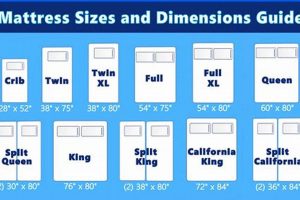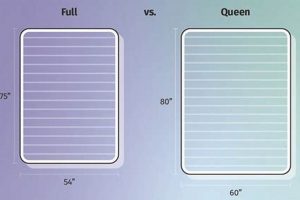A standard full-size mattress, also known as a double, measures approximately 54 inches wide and 75 inches long. In contrast, a queen-size mattress offers a larger surface area, typically measuring 60 inches wide and 80 inches long. This dimensional variation primarily affects the sleeping space available to occupants, particularly in terms of width and overall length.
The selection of an appropriate mattress size significantly impacts sleep quality and comfort levels. The enhanced space provided by a larger sleeping surface can lead to reduced sleep disruption and improved individual comfort, particularly for couples or individuals who prefer more room to move during sleep. Historically, mattress sizes have evolved to accommodate changing lifestyle preferences and the growing emphasis on improved rest and recovery.
The ensuing discussion will delve into the practical implications of these dimensional discrepancies, exploring aspects such as suitability for various room sizes, accommodation of multiple sleepers, and the availability of corresponding bedding and accessories. Factors such as individual sleep preferences, budget constraints, and long-term usage scenarios will also be considered to inform a sound purchasing decision.
Choosing Between Full and Queen Mattresses
Selecting the correct mattress size is crucial for optimizing sleep quality and space utilization. Below are important factors to consider when deciding between a full and a queen mattress.
Tip 1: Assess Room Dimensions: Measure the intended bedroom space. A queen mattress, being larger, requires more floor area to allow for comfortable movement and placement of other furniture. Ensure adequate space exists before opting for a queen.
Tip 2: Evaluate Occupancy: A full mattress is generally suitable for single sleepers. Couples, however, often benefit from the added space of a queen mattress to minimize sleep disturbances caused by movement.
Tip 3: Consider Budget Constraints: Queen mattresses, along with corresponding bedding and frames, typically incur a higher cost compared to full-size alternatives. Account for this price difference when making a purchasing decision.
Tip 4: Analyze Sleep Style: Individuals who tend to move frequently during sleep might find a queen mattress more accommodating. The extra space can prevent feelings of confinement and promote better rest.
Tip 5: Research Bedding Availability: Queen-size bedding is generally more widely available and offers a greater variety of styles and materials. Ensure that desired bedding options are accessible for the chosen mattress size.
Tip 6: Think About Future Needs: Consider potential changes in living arrangements or relationship status. Choosing a queen mattress may provide more versatility for future scenarios involving shared sleeping arrangements.
Prioritizing these considerations ensures a mattress choice that aligns with individual needs and lifestyle factors, contributing to improved sleep quality and overall well-being.
The subsequent sections will examine the long-term implications of each mattress size, focusing on factors like durability, comfort, and health benefits.
1. Size Dimensions
The size dimensions represent a fundamental determinant in differentiating a full and a queen mattress. A full mattress, measuring approximately 54 inches in width and 75 inches in length, offers a sleeping surface area suitable primarily for single adults or smaller spaces. A queen mattress, with its dimensions of approximately 60 inches in width and 80 inches in length, presents a significantly larger surface, which directly translates to increased individual comfort or the capacity to accommodate two adults with greater ease. Consequently, the dimensional variance directly impacts the sleeping experience, affecting factors such as motion transfer, personal space, and overall sleep quality. For instance, a couple sharing a full mattress may experience more sleep disruption due to limited individual space, whereas the expanded dimensions of a queen mattress mitigate this issue.
Further analysis reveals that the practical significance of the size dimensions extends beyond mere surface area. The increased width of a queen mattress allows for more comfortable positioning, particularly for individuals who tend to move during sleep. The added length caters to taller individuals, preventing discomfort associated with restricted legroom. Moreover, the choice between a full and a queen mattress, guided by size dimensions, influences room layout and design. Smaller bedrooms may be better suited to the more compact footprint of a full mattress, while larger rooms can comfortably accommodate a queen, providing greater flexibility in furniture placement and overall room aesthetics. In essence, dimensional considerations become integral to optimizing both the sleeping environment and the surrounding living space.
In summary, the size dimensions are a core component defining the distinction between a full and a queen mattress. These dimensional differences directly affect sleeping comfort, occupancy capacity, and spatial efficiency. While a full mattress caters to individual sleepers and smaller environments, a queen mattress provides enhanced comfort for couples and offers greater design flexibility in larger rooms. Understanding the practical implications of these dimensional variations is crucial for selecting a mattress that aligns with individual needs and spatial constraints, thereby optimizing sleep quality and overall living comfort.
2. Sleeping Space
The most salient distinction between a full and a queen mattress lies in the available sleeping space. The dimensional disparity directly influences comfort, particularly for couples or individuals who prefer ample room to move during sleep. A full mattress offers approximately 27 square feet of sleeping surface, while a queen mattress provides approximately 33.3 square feet. This translates to an additional 6.3 square feet on a queen, an area significant enough to affect sleep quality and reduce disturbances caused by a partner’s movements. The smaller surface of a full mattress may lead to a feeling of confinement for some individuals, especially those accustomed to more spacious sleeping arrangements. For example, two adults sharing a full mattress may experience more frequent awakenings due to limited personal space, while the extra width and length of a queen offer improved comfort and reduced motion transfer.
The practical implications of this increased sleeping space extend beyond mere comfort. A larger sleeping surface can accommodate varying sleep positions and reduce the likelihood of physical contact that might disrupt sleep. Couples sharing a bed often find that a queen mattress minimizes conflicts over space and allows for more restful sleep cycles. Furthermore, the enhanced sleeping space can be particularly beneficial for individuals with certain medical conditions, such as back pain or sleep apnea, who may require specific sleep positions or adjustments throughout the night. In addition to individual comfort, the sleeping space influences the longevity of the mattress itself. Overcrowding and uneven weight distribution on a smaller full mattress can lead to premature wear and tear, while the more spacious queen mattress provides greater surface area for distributing weight, potentially extending its lifespan.
In conclusion, the sleeping space offered by a mattress is a critical factor in determining its suitability for individual or shared occupancy. The difference in surface area between a full and a queen mattress directly impacts sleep quality, comfort, and the durability of the mattress. While a full mattress may suffice for single sleepers or smaller spaces, the enhanced sleeping space of a queen mattress offers significant advantages for couples and individuals who prioritize comfort and undisturbed rest. Choosing between a full and a queen, therefore, necessitates careful consideration of sleeping habits, occupancy requirements, and long-term comfort needs.
3. Room Compatibility
The selection of a mattress size is intrinsically linked to the dimensions of the room in which it will be placed. Room compatibility, therefore, represents a critical determinant in the choice between a full and a queen mattress. A queen mattress, due to its larger footprint, necessitates a more spacious room to ensure comfortable movement and avoid a sense of constriction. The placement of a queen mattress in a smaller room can impede accessibility to other furniture, disrupt the room’s aesthetic balance, and create a feeling of spatial confinement. For example, a bedroom measuring less than 10 feet by 10 feet may feel significantly cramped with a queen mattress, hindering ease of movement around the bed and potentially obstructing access to closets or doorways. In contrast, a full mattress, with its comparatively smaller dimensions, offers a more suitable option for limited spaces, allowing for a more balanced and functional room layout.
The impact of room compatibility extends beyond mere spatial considerations. The ability to freely navigate a bedroom, to comfortably access storage areas, and to maintain a sense of openness all contribute to psychological well-being and overall comfort. Overcrowding can lead to feelings of anxiety and claustrophobia, while a well-proportioned room fosters a sense of calm and relaxation. Thus, the selection of a mattress size that is appropriately scaled to the room dimensions directly influences the perceived comfort and functionality of the living space. Furthermore, the choice of mattress size can affect the placement and arrangement of other furniture, such as nightstands, dressers, and chairs. A larger queen mattress may limit the options for furniture placement, while the smaller full mattress offers greater flexibility in designing the room layout.
In summary, room compatibility stands as a significant factor in discerning the suitability of a full versus a queen mattress. The practical implications extend beyond mere spatial constraints, influencing both the psychological comfort and the functional efficiency of the bedroom. Careful consideration of room dimensions, furniture placement, and overall room aesthetics is crucial in selecting a mattress size that promotes a harmonious and comfortable living environment. Ultimately, the objective is to achieve a balance between mattress size and room dimensions to optimize both sleep quality and overall room functionality.
4. Cost Implications
The financial aspect represents a significant differentiating factor when evaluating a full versus a queen mattress. The purchase price is not the sole consideration; the total cost encompasses the mattress itself, associated bedding, frames, and potential long-term replacement costs. A thorough examination of these multifaceted expenses is essential for informed decision-making.
- Initial Purchase Price
The upfront cost of a queen mattress typically exceeds that of a full-size equivalent. This price differential stems from the increased material usage required to manufacture the larger mattress. For instance, a mid-range memory foam queen mattress might cost 20-40% more than a comparable full-size model. Budget-conscious consumers must weigh the comfort benefits of a queen against this increased initial expenditure. The difference varies across brands and material composition; higher-end models exhibit a more pronounced price gap.
- Bedding and Accessories
Associated bedding, including sheets, comforters, and mattress protectors, also contribute to the overall cost. Queen-size bedding generally commands a higher price point than full-size alternatives. This disparity arises from the increased fabric requirements to accommodate the larger mattress dimensions. Consumers should factor in these recurring expenses when comparing the long-term financial implications of each mattress size. Furthermore, specialty items, such as adjustable bed frames, often exhibit a greater cost premium for queen sizes.
- Frame and Support Systems
The bed frame or support system represents another area where cost differences manifest. Queen mattresses require sturdier frames capable of supporting their increased weight and dimensions. This often translates to a higher cost for queen-size frames, particularly those constructed from premium materials or incorporating advanced features. While a full-size mattress may be adequately supported by a simpler, less expensive frame, a queen mattress necessitates a more robust and, consequently, pricier foundation.
- Longevity and Replacement Costs
While not an immediate expense, the potential for differential longevity impacts the long-term cost considerations. The increased sleeping space and weight distribution of a queen mattress may contribute to a more even wear pattern, potentially extending its lifespan compared to a full mattress experiencing concentrated wear. Conversely, higher initial costs might necessitate delaying replacement, even if optimal comfort levels diminish. Therefore, assessing the anticipated lifespan and associated replacement costs is crucial for a comprehensive financial analysis.
In conclusion, the cost implications associated with selecting between a full and a queen mattress extend beyond the initial purchase price. Bedding, frame requirements, and long-term durability all contribute to the total cost of ownership. A thorough evaluation of these factors enables consumers to make a financially prudent decision that aligns with their budget and comfort preferences. The incremental benefits of a queen mattress, such as increased sleeping space, must be carefully weighed against the corresponding increase in overall expenses.
5. Bedding Options
The availability and variety of bedding options are directly influenced by mattress size. A full mattress, due to its standardized dimensions, has a readily accessible market for corresponding sheets, comforters, and other bedding accessories. The consistency in size across manufacturers leads to a wide array of styles, materials, and price points. Conversely, while queen-size bedding is also widely available, consumers may encounter variations in fit depending on the specific brand or manufacturing standards. For example, a deep-pocket sheet set intended for a thicker queen mattress might not fit snugly on a thinner model, leading to discomfort or reduced aesthetic appeal. This discrepancy highlights the importance of verifying measurements and considering mattress depth when selecting queen-size bedding.
Furthermore, the aesthetic considerations surrounding bedding choices are amplified by the visual impact of mattress size on the overall room decor. A larger queen mattress commands more visual attention within the room, making the selection of complementary bedding crucial for achieving a cohesive design. While a simple, neutral-toned bedding set might suffice for a smaller full mattress, a queen mattress often benefits from more elaborate patterns, textures, or colors to create a focal point and enhance the room’s visual appeal. Moreover, the functional aspects of bedding, such as warmth and breathability, are also influenced by size. A larger comforter on a queen mattress provides greater coverage and warmth compared to a smaller full-size alternative, making it a more suitable choice for colder climates. Conversely, lighter, more breathable materials may be preferred for warmer environments to prevent overheating.
In conclusion, the relationship between bedding options and mattress size is multifaceted, encompassing availability, fit, aesthetic considerations, and functional performance. While both full and queen mattresses offer a range of bedding choices, the specific requirements and considerations vary depending on the dimensions of the mattress and the individual preferences of the consumer. Careful attention to measurements, materials, and design elements is essential for selecting bedding that complements the mattress size and enhances the overall sleeping experience. The selection of suitable bedding reinforces the functional benefits of the chosen mattress size and enhances the rooms aesthetic appeal.
6. Occupancy Needs
Occupancy needs, delineating the number and size of individuals intending to use a mattress, serve as a primary determinant in the selection between a full and a queen size. A full mattress, measuring approximately 54 inches wide, is typically suitable for single occupants or, in limited circumstances, two smaller individuals. The restricted width, however, often results in compromised sleep quality for couples due to limited personal space and increased motion transfer. A queen mattress, at 60 inches wide, offers a marginally wider surface area that more comfortably accommodates two adults, mitigating disruptions caused by shared occupancy. For instance, a single adult sleeper might find a full mattress adequate, while a couple sharing the same mattress may experience discomfort and restlessness due to the limited individual space.
The practical significance of understanding occupancy needs extends beyond mere comfort. Consistent sleep disturbances resulting from inadequate space can lead to long-term health consequences, including increased stress levels, reduced cognitive function, and compromised immune response. Furthermore, the type of occupancy influences the expected lifespan of the mattress. A full mattress regularly used by two adults will likely experience accelerated wear and tear compared to the same mattress used by a single individual. This directly impacts the long-term cost-effectiveness of the mattress choice. For example, couples might find that investing in a more durable queen mattress, despite the higher initial cost, proves more economical in the long run due to its prolonged lifespan.
In conclusion, occupancy needs dictate the minimum acceptable mattress size to ensure adequate comfort and prevent sleep disturbances. While a full mattress may suffice for single sleepers or temporary use, a queen mattress offers superior accommodation for couples, promoting better sleep quality and potentially extending the lifespan of the mattress. Therefore, assessing occupancy needs is crucial for selecting a mattress that aligns with intended usage and contributes to long-term health and well-being.
Frequently Asked Questions
This section addresses common inquiries and misconceptions regarding the key distinctions between full and queen mattresses, providing clarity for informed purchasing decisions.
Question 1: Is a queen mattress significantly larger than a full mattress?
Yes, a queen mattress measures 6 inches wider and 5 inches longer than a full mattress. This dimensional difference provides significantly more sleeping space, particularly beneficial for couples.
Question 2: Can a full mattress comfortably accommodate two adults?
While a full mattress can technically accommodate two adults, the limited width often results in a cramped sleeping experience and increased sleep disruption. A queen mattress is generally recommended for couples.
Question 3: Does mattress size impact bedding costs?
Yes, queen-size bedding typically incurs a higher cost than full-size bedding due to the increased fabric requirements. This should be factored into the overall budget.
Question 4: How does room size affect mattress choice?
A queen mattress requires a larger room to ensure comfortable movement and avoid a feeling of spatial constriction. A full mattress is often better suited for smaller bedrooms.
Question 5: Are queen mattresses more durable than full mattresses?
Durability is primarily determined by mattress construction and materials, not solely by size. However, the larger surface area of a queen mattress can distribute weight more evenly, potentially extending its lifespan under shared occupancy.
Question 6: What are the key considerations for choosing between a full and a queen mattress?
Key considerations include occupancy needs, room size, budget, individual sleep preferences, and long-term usage scenarios. A thorough assessment of these factors facilitates a suitable mattress selection.
These responses offer a concise overview of the most pertinent distinctions between full and queen mattresses, enabling a more confident and informed purchasing process.
The ensuing sections will delve into specific mattress types and materials, further refining the selection criteria for optimal sleep quality.
Difference Between a Full and a Queen Mattress
This exploration has detailed the key distinctions that define “difference between a full and a queen mattress.” Dimensional disparities impact sleeping space, room compatibility, and cost implications. Full mattresses, with smaller dimensions, suit single sleepers and confined spaces, while queen mattresses offer enhanced comfort for couples. Ultimately, occupancy needs and budget constraints dictate the optimal choice. A thorough evaluation of these elements ensures a selection aligned with individual requirements.
The decision regarding the “difference between a full and a queen mattress” should therefore be approached with diligence. Understanding the inherent trade-offsspace versus comfort, affordability versus long-term valueis crucial. Thoughtful deliberation leads to an investment in enhanced sleep quality and overall well-being. It is a purchase for now and the future.







